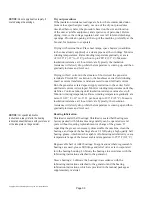
Page 35
Copyright © 2012 Kato Engineering, Inc. All rights reserved
Winding rated
voltage (V)
*
Insulation
resistance test
direct voltage
(V)
<1000
500
1000-2500
500-1000
2501-5000
1000-2500
5001-12000
2500-5000
>12000
5000-10000
Table 5
Guidelines for DC voltages to be
applied during insulation resistance
tests
*
Rated line-line voltage for three-phase
ac machines, and line-to-ground voltage
for single-phase machines, and rated
direct voltage for dc machines or fi eld
windings.
Exciter armature
1. Disconnect the exciter armature leads from the rotating rec tifi ers.
2. Connect the leads of the exciter armature to one clamp of a 500-volt
megger, and connect the other clamp to a suitable connection on
exciter sleeve or shaft.
3. Apply 500 V from the megger, and measure the resistance reading
after 1 minute. The reading must be a minimum of 50 megohms. If it
is not, refer to the cleaning or dry out procedures.
4
.
Ground the exciter leads to the exciter sleeve or shaft after
disconnecting the megger. This will allow the voltage build up to be
properly discharged.
Main rotor
1. Disconnect the generator fi eld leads from the posi tive and negative
terminals of the rotating rectifi er assembly.
2. Connect the positive and negative leads to one clamp of the megger,
and connect the other clamp to the shaft.
3. Apply voltage from the megger, and measure the resistance reading
after 1 minute. The reading must be a minimum of 50 megohms. If it
is not, refer to the cleaning or dry out procedures. (See Table 5).
4. Ground the fi eld leads to the shaft after disconnecting the megger for
a minimum of 1 minute. This will allow the voltage build up to be
properly discharged.
Main stator
1. Disconnect power connections and all control appara tus from the
generator terminals.
2. Measure insulation resistance of each phase separately with the two
other phases shorted to the frame.
3. Use a megger connected between the lead(s) of the phase to be
measured and generator frame. The minimum 1-minute insulation
resistance must not be less than 50 megohms. (See Table 5).
4.
Ground the leads to the frame after the 1-minute megger test. This
will allow the voltage build up to be properly discharged.
















































